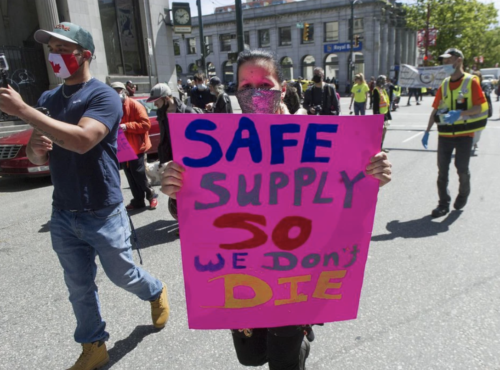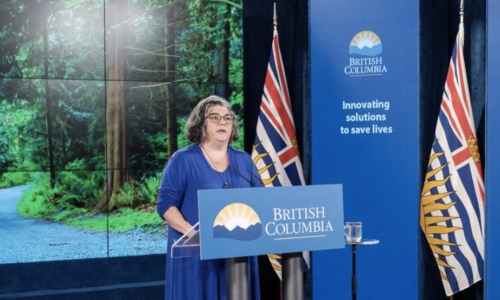British Columbia, Canada, into its 5th year of opioid health emergency, will be the first province to introduce a safe drug supply in an effort to reduce the staggering number of overdose deaths.
In the past 25 years,
more than 12,632 British Columbians
have died of illicit drug overdoses.
B.C.’s chief coroner Lisa Lapointe said overdose is the 4th highest cause of death in the province with the average age being 43.
The death rate began to climb in 2011, but skyrocketed to 991 in 2016, the year, then-provincial health officer Dr. Perry Kendall declared the health crisis.
Nearly 7,000 have perished since that declaration. Deaths hit a high in 2020, with 1,724 people succumbing to highly potent illicit drugs.
(In comparison, British Columbia has lost 1761 lives to Covid-19 since March 2020.)
B.C. to Offer Canada’s First,
Permanent Safe Drug Supply
in Response to Overdose Crisis

Several dozen protestors march through the Downtown Eastside of Vancouver, BC Tuesday, May 11, 2021 calling for a safe supply of street drugs. PHOTO BY JASON PAYNE /PNG
The initiative will start by offering opioid replacements, including fentanyl patches. Stimulants will come later. Prescribed heroin is not included in the program, because of a lack of supply.
By Lori Culbert, Dan Fumano, Vancouver Sun, July 15, 2021
B.C. will be the first province in Canada to permanently provide access to a safe drug supply, in an effort to reduce a staggering number of overdose deaths — a groundbreaking step that is being hailed as life-saving but also criticized for taking so long to achieve and not going far enough.
The move comes after more than 7,000 British Columbians have died from toxic drugs since a public health emergency was declared in 2016 — a crisis that grew worse with the introduction of pandemic restrictions.
And the new rollout will begin slowly, at pre-existing clinics that already offer pharmaceutical replacement drugs as part of a trial program. It will at first offer just opioid replacement options, including fentanyl patches and tablets. Stimulants or prescribed heroin will not be part of the first phase.
In response to questions about whether the government is acting quickly enough to save the lives of drug users who are being fatally poisoned at a rate of five people a day, officials with the Ministry of Mental Health and Addictions argued they are moving as fast as they can with the innovative program.
“I would have loved it to be faster, I would have loved to have prevented (the overdose deaths) from happening,” Provincial Health Officer Dr. Bonnie Henry, who called for a regulated opioid supply two years ago, said at the government announcement Thursday.
“(But) we’ve learned a lot about what people need, the substances people need to support them now. And I’m just happy we’re moving forward as quickly as we can right now.”
Dr. Bonnie Henry, Provincial Health Officer, announced that to help save lives by separating more people from the poisoned illicit drug supply, British Columbia is phasing in a new policy to expand access to prescribed safer supply.

Dr. Bonnie Henry, Provincial Health Officer, announced that to help save lives by separating more people from the poisoned illicit drug supply, British Columbia is phasing in a new policy to expand access to prescribed safer supply. PHOTO BY DON CRAIG /PNG
At the beginning of the COVID-19 pandemic, which exacerbated the existing overdose crisis, the B.C. government created a temporary safe supply program, allowing doctors and nurses to prescribe medication alternatives to substances, including opioids, alcohol, stimulants and benzodiazepines.
Now, $22.6 million has been earmarked over the next three years for the five health authorities to make this safe supply a permanent option, starting with opioids.
Fentanyl patches had previously been offered in a limited trial project, and that will now be significantly expanded.
“Nowhere else in Canada can anybody be prescribed a fentanyl patch for this purpose, so that really is a breakthrough, and is based on input that we heard strongly through our consultations (with drug users),” Mental Health and Addictions Minister Sheila Malcolmson told Postmedia, adding she doesn’t agree the program rollout is moving too slowly.
“When you are the first, then sometimes it takes a little bit longer than you’d like … (but) absolutely, we feel the urgency of the public health emergency.”

Mental Health and Addictions Minister Sheila Malcolmson
The government’s announcement said the first phase of the initiative will be in place for 18 to 24 months, starting with the expansion of health authority programs that already prescribe alternatives to illicit drugs.
Many of those clinics are urban and at capacity, but the province plans to extend these services to more remote areas with a combination of more staff and resources at existing clinics, plus adding new programs and outreach teams.
Malcolmson said the five health authorities must report back to government in the next two weeks with their implementation plans, and more details will be known then.
“We think that it might take three to six months for actual things on the ground for the patient,” she said.

Sheila Malcolmson, Minister of Mental Health. PHOTO BY DON CRAIG /PNG
Dr. Shannon McDonald, acting chief medical health officer of the First Nations Health Authority, said there are issues that need to be addressed for rural communities, such as training health-care providers so they are comfortable prescribing these drugs, and figuring out how to safely transport the drug supply from the city.
“There are some potential challenges related to the rollout of this program to ensure that it fulfills the cultural, health and wellness needs of First Nations, and especially for those who use drugs,” said McDonald, who added Indigenous people are disproportionately victims of the overdose crisis.
“We know that there continues to be barriers for Indigenous people based on differential access, less trust, and racism experienced in the health-care system.”

Paramedics respond to an emergency medical call in the 100-block E. Hastings Street in Vancouver, BC, April 22, 2021. PHOTO BY JASON PAYNE /PNG
Donald MacPherson, executive director of the Canadian Drug Policy Coalition at Simon Fraser University, said: “In normal times, this would be significant progress.”
But, he said, the severity of the current long-running crisis means these are not normal times.
People in the provincial government have been working hard to provide a way to access “pharmaceutical alternatives to the totally deadly illegal drug market,” MacPherson said.
But the problem with the program, he said, is its “highly medical context” means it will be limited to those “who can navigate the health system, who have a doctor, or have a connection with a nurse who can prescribe.”
“Many people don’t have those connections, and their use of health services is the emergency ward, primarily,” he said.
While Thursday’s changes put B.C. at the forefront of North American jurisdictions on these kinds of interventions, MacPherson said, “It’s not good enough for B.C. to say, ‘We’re doing more than anybody else.’ When the results are better than other places, then let’s talk about that. Our results are terrible, and we’re really just scratching the surface.”
“This is not an emergency response, it’s an incremental response,” MacPherson said. “I’m happy that something is happening, but it’s very sad that we as a society are just at the beginnings of crafting a new system for people to access a safer supply of substances, after so many years of so many deaths.”

A man sits slumped over, surrounded by drug paraphernalia, in an alley behind the 100-block East Hastings Street in Vancouver on Thursday, February 11, 2021. PHOTO BY JASON PAYNE /PNG
Vince Tao, a community organizer with the Vancouver Area Network of Drug Users, said: “This step is a decent one. But it is, as always, too little, too late.”
Tao said it seems unusual the policy includes fentanyl patches and injectable hydromorphone, but not heroin, which has been prescribed in a limited capacity in B.C. for years.
Researchers from Providence Health Care and the University of B.C. led North America’s first clinical trial of prescribed heroin back in 2005.
Malcolmson said prescription heroin is not being included at this time because the government has not been able to find a domestic supply.
She had no timeline on its inclusion, but said the government would continue to look for a reliable provider.
She also “recognized there is a need” to include replacements for stimulants — the category of street drugs including cocaine and amphetamines — in the program, but could not say when that would happen.
Henry said roughly 6,000 drug users have accessed some type of safe supply during the temporary program over the last year, but there are an estimated 60,000 British Columbians with a substance use disorder.
“There is no one single measure that is going to get us out of the toxic drug crisis, but this is one more step in the right direction,” Henry added.

